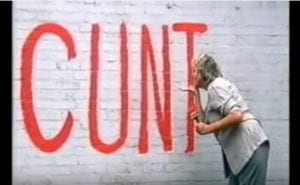Aunt Mavis’ Basket Maker: Germaine Greer’s CUNT index cards
Carly Pettiona
The Germaine Greer Archive offers insight into the thoughts, correspondences, writing and planning processes of one of the most controversial and well-known feminists of the 20th century. This archive includes a collection of index cards she made while writing and editing The Female Eunuch. Nestled in the collection, between index cards that contain notes about references and commentary on history, there are two cards simply labelled CUNT (Items: 2014.0039.0351 and 2014.0039.0358). Both are dated 1968 and have been digitised as part of the curation of the Germaine Greer archive undertaken by the University, and you can learn more about the index cards from Rachel Buchanan’s University of Melbourne Archives blog post.

As a feminist linguistic researcher investigating anti-feminist hate mail, I was intrigued by the CUNT index cards which include lists of different descriptive words for female genitalia. The terms range from the common, twat, snatch, pussy, boobs, knockers, to the incredibly curious, broom, ace (of spades), attic, aunt mavis, bank, basket maker, bee-hive, bird’s next … and the list goes on (literally!). While the shorter entry (0351) has just two lists, each with six entries, the first topped with CUNT and the second topped with TITS; the longer entry (0358) appears to be the start of an alphabetical list indexing a range of terms that are used for vagina, as they all start with A or B.
Rather than shocking or offensive, it is quite entertaining to read a list like this, enjoying the taboo nature of the terms Greer has encountered and imagining how the users invented such colourful metaphors (bee-hive in particular continues to fascinate…). In her 1970 essay, The politics of female sexuality (Greer, 1986), Greer argues for the need, “to establish a woman’s vocabulary of cunt, prideful, affectionate, accurate, bold,” thus indicating a deliberate and persistent research and linguistic interest (1986, p. 38). Again, in the same volume, Greer writes encouragingly, Lady love your cunt, “give it your own loving names, not the fiction of anatomy books, or the condescending diminutives that men use, like pussy, twat, box or the epithets of hate, like gash, slit, crack. What we need is a genuinely descriptive terminology of cunt,” (p. 77). At a time when feminism was fighting for women’s autonomy over their bodies and urging them to learn more about their own anatomy and sexuality in books such as Our Bodies, Ourselves, first released in 1970 (Our Bodies Ourselves, 2017). It gave women accessible information about women’s bodies and welcomed curiosity and collective sharing of female experience. Greer’s fascination with this word, cunt, thus had a purpose, both within her career and within the context of feminism at the time. Far from engendering anxiety, the juxtaposition of derogatory and humourous words for cunt, these lists seem to have helped her to develop a more empowered vocabulary for female genitals.
More than thirty years later, in 2006, Greer starred in a BBC show, Balderdash & Piffle, that traced interesting words from the Oxford English Dictionary and she, of course, spoke about cunt (BabyradfemTV, 2016). In this segment, Greer talks about the word’s history, and of her own attempt to cement cunt in the female lexicon in the 1970s. Although Greer admits that she was not entirely successful in this quest for people to love the word cunt, she ends by reflecting upon how perhaps the taboo nature of the word demonstrates its power, a power that Greer does not want cunt to lose.
Through investigating a few taboo words, Greer was able to identify linguistic evidence for gender inequality and use this knowledge to further her understanding and therefore her arguments against the patriarchal view of women and female sexuality. As a linguist, I understand the power of words, and as a feminist, I understand the misogyny that underlies language, but studying a small snippet of Greer’s history with cunt I have begun to see more than just the problematic nature of this language. My investigation of Greer’s history with the word cunt has allowed me a brief window of insight into the development of Greer’s feminism and has whet my appetite to continue digging through this rich and fascinating archive.
References
BabyradfemTV. (2016). Germaine Greer on the Etymology of “the C word.” Retrieved from https://www.youtube.com/watch?v=Vy36G-BRFRQ
Greer, G. (1986). The madwoman’s underclothes : essays and occasional writings 1968-85. London: Pan Books.
Our Bodies Ourselves. (2017). Reading “Our Bodies, Ourselves.” Retrieved September 7, 2017, from http://www.ourbodiesourselves.org/history/reading-our-bodies-ourselves/
University of Melbourne Archives, & Greer, G. (1939a). Cunt, 2014.0039.00351.
University of Melbourne Archives, & Greer, G. (1939b). Cunt, 2014.0039.00358.

Leave a Reply